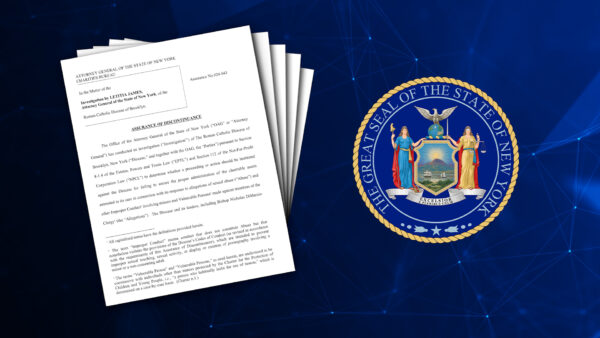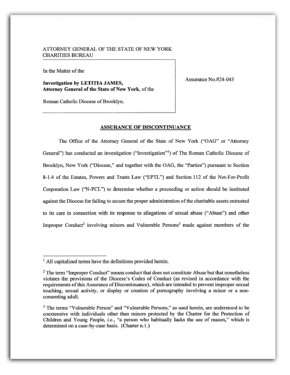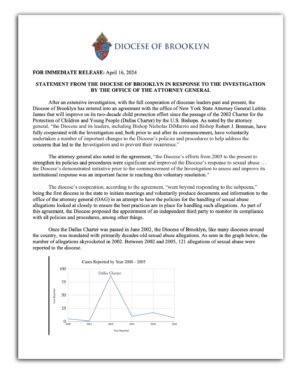
PROSPECT HEIGHTS — Results of an investigation issued by New York Attorney General Letitia James highlights both shortcomings and positive initiatives taken by the Diocese of Brooklyn in its handling of clergy sexual abuse allegations over the past 22 years.
The 75-page document, published on April 16, focuses on allegations since 2002, when the Catholic Church first set up a comprehensive set of procedures, still in place today, called the “Charter for the Protection of Children and Young People.”
It found that the diocese, on multiple occasions, did not always complete investigations in a timely manner, properly monitor clergy with credible abuse allegations against them, or be transparent with parishioners about a priest’s status.
Her report also said that the Diocese of Brooklyn “failed to consistently comply with its own policies and procedures for responding to sexual abuse.”
The report states that diocesan leadership — specifically Bishop Robert Brennan and Bishop Emeritus Nicholas DiMarzio — fully cooperated with the attorney general’s investigation. Responding to the report, Bishop Brennan apologized to victims of clergy abuse and emphasized that the diocese will now move forward with its strongest protection policies.
“This agreement concludes a difficult period in the life of the Church. While the Church should have been a sanctuary, I am deeply sorry that it was a place of trauma for the victims of clergy sexual abuse,” Bishop Brennan said in a statement.
“I pray God’s healing power will sustain them,” Bishop Brennan added about abuse survivors.
Bishop DiMarzio said in an April 16 statement that he “thought it was best to voluntarily enter into an agreement” with the attorney general’s office to provide “documentation of the work we have done over the last 20 years in the effort to protect children,” and to be advised on ways the diocese could do better.
“Sexual abuse is a crime and a grave sin. It should never have happened within society, but especially the Church,” he said. Bishop DiMarzio also noted that he had “worked tirelessly” throughout his episcopacy “to address the resulting trauma and pain caused to victim-survivors.” He also said he is “proud of the processes we established in the Brooklyn Diocese to make sure this never happens again.”
The attorney general’s office began its investigation into the eight New York Catholic Dioceses in September 2018. In October 2022, James reached a settlement with the Diocese of Buffalo. Investigations into the Archdiocese of New York and the Dioceses of Albany, Ogdensburg, Rochester, Rockville Centre, and Syracuse remain ongoing.
The report on the Diocese of Brooklyn also states it “acknowledges the Diocese’s cooperation with this investigation, negotiation, and agreement,” and added that the agreement “specifically addresses the failures of the Diocese’s institutional response to the crisis of clergy sexual abuse and does not affect pending claims for damages that have been asserted by individual survivors of abuse against the Diocese.”
James’ office reviewed diocesan files concerning 33 clergy, 18 who had credible allegations of abuse against them, and 15 who had abuse allegations against them deemed not credible or unsubstantiated.
Diocesan data indicates that there were 121 abuse allegations made between 2002 and 2005, more than 75 of which were made in 2002. All of those allegations were immediately sent to the appropriate district attorney and the New York City Police Department (NYPD) Special Victims Unit, according to the diocese.
“Now, the Diocese has made a commitment to implementing holistic reforms that will ensure every report of sexual abuse or misconduct is handled quickly and transparently,” said James.
The report also acknowledged that since the U.S. Conference of Catholic Bishops (USCCB) adopted new procedures and protocols for bishops and dioceses to follow, the Diocese of Brooklyn has taken a number of additional steps to strengthen its own policies and procedures.
Under Bishop DiMarzio, in 2004 the diocese established the Office of Safe Environment, and the Office of Victim Assistance Ministry, which together make up the Diocesan Support and Safe Environment Offices. Both offices oversee the diocese’s policies and procedures related to clergy abuse allegations, and to support victim-survivors.
Nearing the end of Bishop DiMarzio’s tenure, he established an Office of Protection of Children and Young People. Established in 2021, the office created a position to monitor credibly accused priests, enhanced existing protocols, and strengthened the communication between the diocese and the NYPD Special Victims’ Unit.
In all, during Bishop DiMarzio’s ministry, public statements were released about the outcome of Diocesan Review Board investigations that led to the removal of 27 priests from ministry. He also issued 41 other communications regarding the sex abuse crisis, according to the diocese.
Meanwhile, in April 2022, Bishop Brennan made effective the diocese’s new “Policies and Procedures Regarding Sexual Abuse of Minors by Priests or Deacons,” or what’s commonly known as the “Diocesan SAP Policy.” In January 2022, Bishop Brennan also implemented separate “Codes of Conduct for Employees, Volunteers, and Clergy.”
Many of the diocesan shortcomings highlighted in the report, however, took place before any of the aforementioned improvements were in place. Bishop DiMarzio was in charge of the diocese through the years the report focuses on. He was appointed to the diocese in October 2003, and led the diocese until his retirement in November, 2021.
Specifically, over that time the report found that:
- The bishop applied inconsistent standards to determine if an abuse allegation was credible, which “resulted in inconsistent and, at times, incorrect determinations.” Sometimes, the report states, this left credibly accused clergy in ministry without precautions being taken.
- The diocese failed to properly monitor some priests against whom allegations were made, including those placed on administrative leave or were confined to a life of prayer or penance, according to the report.
- Occasionally, the diocese delayed completing its investigations, and taking other steps required by its policies and procedures, such as disclosing changes in the status of credibly accused clergy, the report states.
- The diocese lacked certain policies and procedures, including a whistleblower policy, according to the report.
- Diocesan personnel occasionally did not comply with policies and procedures concerning internal reporting of relevant information regarding ongoing investigations of clergy abuse allegations, the report states.
Bishop Brennan 2022 Policies, New Protocol and Policy Improvements
In the two-plus years Bishop Brennan has been at the helm of the Diocese of Brooklyn he has made multiple changes and improvements to the diocese’s policies and procedures to address allegations of clergy abuse.
His first action was the implementation of the code of conduct for employees, volunteers, and clergy in January 2022. In September 2022, he also appointed former Manhattan Child Abuse Squad NYPD Detective Elizabeth Harris to monitor all priests removed from ministry. Harris’ position, the 1722 Supervisor in the Office of Protection of Children and Young People, was created by Bishop DiMarzio and filled after he retired. The number 1722 refers to a section of canon law related to the removal of priests.
Arguably most significant, however, are the new policies and procedures Bishop Brennan implemented in April 2022 — a system to ensure that all incidents of reported sexual abuse of minors are referred to appropriate law enforcement officials, and allows anyone who claims they have been sexually abused as a minor to access to counseling and an opportunity to meet with the bishop. These policies and procedures built on similar policies implemented by Bishop DiMarzio.
In the updated policies, the bishop initiates an inquiry into any abuse allegation he receives, unless he determines that such an inquiry would be “entirely superfluous.” From there, the Diocesan Review Board assists the bishop with the inquiry, and a private investigative agency will also be brought in.
Under Bishop Brennan’s leadership, two priests have been removed from ministry following the recommendation of the Diocesan Review Board. Still, because of past shortcomings, he has agreed to James’ request to implement a number of changes to the diocese’s protocols and procedures.
Per the agreement, the diocese will ensure that it maintains and adequately funds the Office of Safe Environment, and the Office of Victim Assistance Ministry, which together make up the Diocesan Support and Safe Environment Offices. Both offices were first established by Bishop DiMarzio in 2004 to oversee the diocese’s policies and procedure related to clergy abuse allegations, and to support victim-survivors.
The diocese has not only agreed to continue to fund and continue the work of these offices, but to increase programs and staff, and increase transparency.
The diocese also will make changes to its safe environment policies, including expanding the methods the diocese uses to receive complaints against clergy. The diocese has committed to creating an online form for receiving complaints, posting information at a prominent place at parishes and schools, and ensuring confidentiality of complaints.
Further, the diocese has also committed to requiring clergy, employees, and volunteers to report all allegations they learn through any manner, except for the sacrament of confession. The diocese will also make sure that all diocesan officials, clergy, and employees are aware that they must report any allegations formally through the diocesan reporting line.
The diocese will also, at least four times per year publicize in The Tablet, and post in all schools and parishes in a prominent location, a statement urging victims abuse and improper conduct to report such crimes to the diocese and local law enforcement. The Tablet displays this information in each weekly edition.
To ensure that these changes are complied with, the diocese has agreed to appoint an independent monitor who will serve a three-year term, effective immediately, and issue a report on compliance each year.
Bishop DiMarzio’s Tenure
In his Nov. 13, 2021, “Put Out Into the Deep” column, Bishop DiMarzio acknowledged that many new abuse allegations had come to light against the diocese because of New York’s Child Victims Act, which enacted a two-year look back period for victim-survivors to file claims. In the same column, he also apologized.
“When abuse happens at the hands of a priest, it is a betrayal. While an apology could never be enough, I am wholeheartedly sorry for the crimes committed against our children by those who represented the Church,” Bishop DiMarzio wrote. “During my time as your bishop for the last 18 years, and with the recent conclusion of the Child Victims Act two-year look back period enacted in the State of New York, we have learned of many new allegations against priests, religious, and laity who ministered in Brooklyn and Queens.”
Bishop DiMarzio went on to admit that there were times that cases were not addressed properly when they came to the attention of the diocese — which aligns with the findings of the attorney general’s report. However, he also defended the diocese, saying that all past and present cases known to the diocese were reported to the corresponding district attorney’s office.
He said that when the diocese began the Independent Reconciliation Compensation Program in 2017, and the lookback window of the Childhood Victims Act was enacted in 2019, “most of these cases were almost entirely unknown to the Church in Brooklyn and Queens.”
“It would be impossible to cover up what we did not know,” he added.
Based on the attorney general’s report, the execution of the diocese’s protocols and procedures was inadequate on a number of occasions post-2002. However, many of the systems the diocese still rely on today — even if in a different form — were established by Bishop DiMarzio.
When he arrived to the diocese in October 2003, he almost immediately established an external toll-free reporting line for victim-survivors to report their abuse allegations. A year later, he created the Offices of Safe Environment, and Victim Assistance Ministry.
In 2015, Bishop DiMarzio held the first Mass of Hope and Healing in the diocese, which has since become an annual tradition. And in 2018, he held a dialogue about sexual abuse in the Church with the faithful that included testimonies and input from abuse survivors.
Independent Investigation Clears Bishop DiMarzio of Abuse Claims
One year after this dialogue took place, Bishop DiMarzio was accused of sexually abusing a young man 50 years earlier and another similar allegation against him was raised the next year.
In 2022, Bishop DiMarzio was exonerated by the Vatican of abuse allegations brought against him by two men who claimed he abused them when they were children and he was a priest in New Jersey.
The Vatican investigation into the two allegations took place under the new procedures for bishop accountability, known as Vos Estis Lux Mundi, and mandates that any allegation of abuse against a bishop must be investigated. The metropolitan, who is the head bishop of an ecclesiastical province (in this case, Cardinal Timothy Dolan of New York), oversaw the Vos Estis investigation.
Cardinal Dolan retained New York attorney John O’Donnell, a former federal prosecutor, and the law firm of Herbert Smith Freehills to conduct the investigation. The law firm then hired former FBI Director Louis Freeh’s firm to conduct the third-party investigation.
Joseph A. Hayden, Jr., the lawyer representing Bishop DiMarzio, noted in a Sept. 1 statement that O’Donnell and Freeh are both former law enforcement officials with proven experience and impeccable integrity, therefore, “the result of their investigation should leave no doubt.”
“I repeat what I have said from the beginning. There is no truth to these allegations,” Bishop DiMarzio said in a statement after the Vatican announcement. “Throughout my more than 50-year ministry as a priest, I have never abused anyone.”
The Vatican said it will not authorize any further canonical process to address the allegations.
In an April 16 statement, Hank Sheinkopf, a spokesperson for Bishop DiMarzio, said that the bishop “surpassed all mandates with the changes he initiated to protect children and report abuse upon arriving in the Diocese of Brooklyn in October of 2003.”
He also pointed out that even before the mandates of the Dallas Charter, the bishop, as leader of the Diocese of Camden, New Jersey, instituted the first toll-free reporting line for victims in the country.
Sheinkopf also noted that Pope Francis appointed Bishop DiMarzio in 2019 to lead an investigation into claims of mishandled cases in the Diocese of Buffalo that resulted in widespread changes.
Bishop DiMarzio has been honored as a champion of a free press. He received the Catholic Media Association’s Bishop John England Award for his defense of First Amendment rights in 2021, as he has consistently allowed diocesan media outlets to cover the news freely and fairly — including the abuse allegations against himself, and any against the diocese.
At the time, he said he takes the role of journalism seriously “because the press ensures we hear all sides of a story and gives the people the information they need as part of an educated and informed society.”
Senior National Correspondent Carol Zimmermann contributed to this story.



